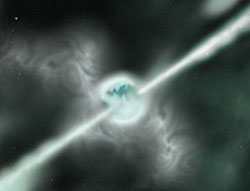NASA discovered the largest gamma ray explosion
 The Fermi telescope of the US Aerospace Agency (NASA) has discovered a massive explosion in the universe that could, according to scientists, be the largest gamma ray explosion ever.
The Fermi telescope of the US Aerospace Agency (NASA) has discovered a massive explosion in the universe that could, according to scientists, be the largest gamma ray explosion ever.
According to "Science Express" on February 19, this strange explosion occurred in the constellation Carina in September 2008, producing an estimated 3,000 to 5 billion times more energy than light's energy. see. Astrophysics experts explain "Visible light has an energy of about 2-3 volts of electrons, but the energy from the explosion is up to millions, even billions of electrons."
Calculating the explosion distance above the earth, experts discovered that the explosion was stronger than the explosions of 9,000 supernovae (powerful explosions occurred at the end of a star's life cycle) and the the air that emits gamma rays initially moves at nearly the speed of light.
Astronomers say gamma-ray bursts occur when stars run out of nuclear fuel and "collapse". They project hundreds of times more light than a typical supernova and about 1 million trillion times more sunlight.
Gamma light bursts longer than 2 seconds usually occur for large stars in the process of collapse, while short bursts of less than 2 seconds occur in smaller stars.
Scientists claim that studying gamma-ray bursts will help them understand more about the origin of the universe.
- The largest gamma ray explosion ever discovered
- Discover the biggest star explosion
- Detecting a strange explosion in a distant galaxy
- The most intense gamma-ray explosion in the universe
- Photograph of early gamma ray burst
- The miniature gamma-ray burst in the laboratory
- Which energy source is the strongest in the universe?
- The thousand-star explosion shot gold, silver and platinum throughout the universe
- Learn about gamma rays and gamma flashes
- Decoding the origin of phenomena
- Earth has been hit by a gamma ray explosion
- Detecting a strange stream of gamma rays in the universe
 Van Allen's belt and evidence that the Apollo 11 mission to the Moon was myth
Van Allen's belt and evidence that the Apollo 11 mission to the Moon was myth The levels of civilization in the universe (Kardashev scale)
The levels of civilization in the universe (Kardashev scale) Today Mars, the sun and the Earth are aligned
Today Mars, the sun and the Earth are aligned The Amazon owner announced a secret plan to build a space base for thousands of people
The Amazon owner announced a secret plan to build a space base for thousands of people